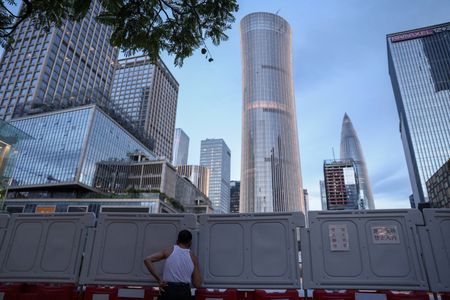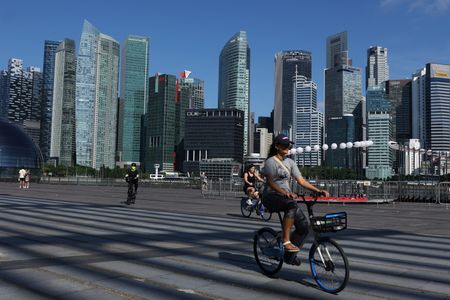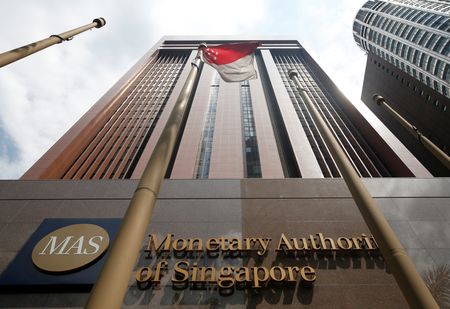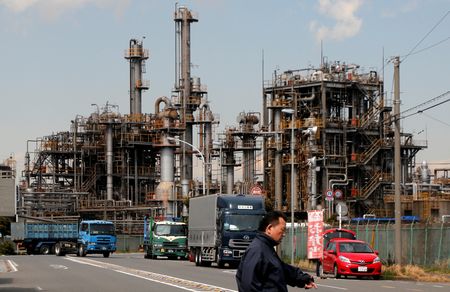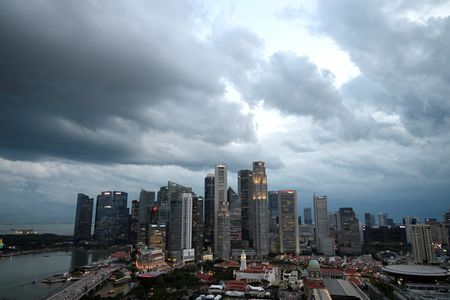By Li Gu and Clare Jim
SHANGHAI/HONG KONG (Reuters) -China’s nascent private REIT market has emerged as a rare bright spot for cash-strapped developers, with a record fundraising pipeline of $12 billion for this year, driven by rising investor demand for higher yields.
Launched in 2023, the private REIT market, restricted to professional investors, has grown rapidly. Developers are drawn to its quicker and more relaxed approval process compared with public REITs and its prospects for revitalising income-generating assets amid the country’s property sector slump.
While public REITs typically focus on consumption-driven properties like shopping malls, private REITs have expanded in scope to include office towers and hotels, attracting both issuers and investors, analysts said.
Stand-alone offices and hotels are currently not permitted to be part of public REITs, which are listed on exchanges.
With most developers shut out of public capital markets, the private REIT market has provided an alternative funding channel, helping commercial asset owners unlock value and ease liquidity pressures.
UBS head of Greater China property research John Lam said private REITs could reshape business models and valuations for property companies.
“Private REITs break through some bottlenecks of public REITs for issuers,” said Lam, who called the new platform “a game changer” for property companies.
However, analysts say it is unlikely to restore the financial health of distressed homebuilders, many of whom do not have high-quality assets to generate stable cash flow.
The surge in private REIT applications comes amid a liquidity crunch in China’s property sector, which began in 2021, leading to numerous developer defaults and a sharp drop in housing demand.
China’s private REITs – classified as asset-backed securities backed by income-generating real estate – are sold through non-public channels to institutional investors.
These vehicles typically bundle commercial assets such as industrial parks, data centers and retail malls, offering periodic returns derived from rental income.
PRIVATE REITS GAIN MOMENTUM
The Shanghai Stock Exchange, the main bourse for such listings, has approved 17 private REITs this year, with an estimated fundraising total of 43 billion yuan ($5.9 billion), a sharp rise from three approvals worth 8 billion yuan last year.
Applications have also surged, with 40 filings so far this year that could raise about 105 billion yuan, compared with just seven applications totalling 13 billion yuan in 2024.
Fundraising via the private REIT route is set to gather pace with some potential issuers firming up roadshow plans while others explore the possibility of tapping the platform, market participants said.
“If you sell directly now, prices are too low and buyers are scarce. REITs solve that,” said John Lim, co-founder of ARA Asset Management in Singapore, adding private REITs in China are seen as a smart way to monetise assets.
Private REITs in China offer an average dividend yield of around 5%, higher than 3%–4% from publicly-listed ones, UBS’s Lam estimated, compensating investors for lower liquidity and longer lock-up periods.
In August, Seazen Group became the first private developer to gain approval for a private REIT, backed by Wuyue Plaza, a shopping mall on Shanghai’s outskirts, to raise 1.06 billion yuan ($149 million).
The REIT’s implied yield is above 6%, according to people with knowledge of the deal, surpassing the 2.1% yield on 30-year government bonds. Morgan Stanley raised Seazen’s shares to overweight in November, citing potential for multiple REIT-led divestments to unlock value from its large mall portfolio.
Distressed developers have yet to tap into the private REIT issuer list, but offshore companies such as Singapore’s CapitaLand and Hong Kong-based Gaw Capital have filed applications this year.
UBS’s Lam said some private developers were turned away from the public REITs market because of strict regulatory requirements on asset quality and restrictions on use of proceeds.
Despite these headwinds, insurers and Chinese brokerage asset management units have emerged as major investors in private REITs, drawn by stable income and competitive yields in a low-interest-rate environment.
STABLE CASH FLOW
Xiao’ou Chen, chairman of Shanghai-based Fields of Gold Capital, said private REITs can secure approvals in just a few months, compared with at least a year for public REITs.
“When the property market was in a fast-growth phase, developers focused on building and selling homes; now that the housing development incremental growth has faded, attention has shifted to revitalising existing stock — income-generating assets with long-term value.”
China’s private REITs complement public REITs, which have grown in value to more than 200 billion yuan in just four years. Analysts say there is significant potential for the private market, inspired by trends in mature economies.
The U.S. has a public-to-private REIT ratio of 1.25 to 1 based on gross asset value, according to UBS data.
REITs make up about 90% and 95% of the property sector’s total market capitalisation in the U.S. and Australia, respectively. In contrast, REITs in China account for just 1.4%, Morgan Stanley analysts said in a note.
Despite the market’s growth prospects, access to high-quality, income-generating assets remains a challenge for issuers.
“Prime office and logistic assets in its tier-one cities are currently facing elevated vacancies, with landlords pressured to lower rents to sustain occupancies,” said Sigrid Zialcita, CEO of Asia Pacific Real Assets Association (APREA).
“The demand-supply imbalance is not likely to reverse before 2027.”
($1 = 7.1159 Chinese yuan)
(Reporting by Li Gu in Shanghai, Clare Jim in Hong Kong, and Yantoultra Ngui in Singapore; Editing by Sumeet Chatterjee and Jacqueline Wong)

